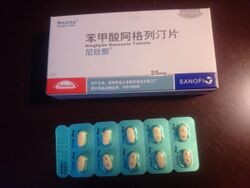Chemistry:Alogliptin
 | |
| Clinical data | |
|---|---|
| Trade names | Nesina, Vipidia Kazano, Vipidomet (with metformin) Oseni, Incresync (with pioglitazone) |
| Other names | SYR-322 |
| AHFS/Drugs.com | Monograph |
| MedlinePlus | a613026 |
| License data |
|
| Pregnancy category |
|
| Routes of administration | By mouth |
| ATC code | |
| Legal status | |
| Legal status | |
| Pharmacokinetic data | |
| Bioavailability | 100% |
| Protein binding | 20% |
| Metabolism | Limited, liver (CYP2D6- and 3A4-mediated) |
| Elimination half-life | 12–21 hours |
| Excretion | Kidney (major) and fecal (minor) |
| Identifiers | |
| |
| CAS Number |
|
| PubChem CID | |
| IUPHAR/BPS | |
| ChemSpider | |
| UNII |
|
| KEGG | |
| ChEBI | |
| ChEMBL | |
| Chemical and physical data | |
| Formula | C18H21N5O2 |
| Molar mass | 339.399 g·mol−1 |
| 3D model (JSmol) | |
| |
| |
| | |
Alogliptin, sold under the brand names Nesina and Vipidia,[1][2]) is an oral anti-diabetic drug in the DPP-4 inhibitor (gliptin) class.[3] Alogliptin does not decrease the risk of heart attack and stroke. Like other members of the gliptin class, it causes little or no weight gain, exhibits relatively little risk of hypoglycemia, and has relatively modest glucose-lowering activity. Alogliptin and other gliptins are commonly used in combination with metformin in people whose diabetes cannot adequately be controlled with metformin alone.[4]
In April 2016, the U.S. Food and Drug Administration (FDA) added a warning about increased risk of heart failure.[5] It was developed by Syrrx, a company which was acquired by Takeda Pharmaceutical Company in 2005.[6] In 2020, it was the 295th most commonly prescribed medication in the United States, with more than 1 million prescriptions.[7][8]
Medical uses
Alogliptin is a dipeptidyl peptidase-4 inhibitor that decreases blood sugar similar to the other.[9]
Side effects
Adverse events include mild hypoglycemia based on clinical studies.[10][11][12] Alogliptin is not associated with increased weight, increased risk of cardiovascular events.[13][14] It may also cause joint pain that can be severe and disabling.[15] In April 2016, the U.S. Food and Drug Administration (FDA) added a warning about increased risk of heart failure.[5]
Market access
In December 2007, Takeda submitted a New Drug Application (NDA) for alogliptin to the United States Food and Drug Administration (USFDA),[16] after positive results from Phase III clinical trials.[1] In September 2008, the company also filed for approval in Japan,[17] winning approval in April 2010.[16] The company also filed a Marketing Authorization Application (MAA) elsewhere outside the United States, which was withdrawn in June 2009 needing more data.[17] The first USFDA NDA failed to gain approval and was followed by a pair of NDAs (one for alogliptin and a second for a combination of alogliptin and pioglitazone) in July 2011.[16] In 2012, Takeda received a negative response from the USFDA on both of these NDAs, citing a need for additional data.[16]
In 2013, the FDA approved the drug in three formulations: as a stand-alone with the brand-name Nesina, combined with metformin using the name Kazano, and when combined with pioglitazone as Oseni.[citation needed]
References
- ↑ 1.0 1.1 "Takeda Submits New Drug Application for Alogliptin (SYR-322) in the U.S." (Press release). Takeda Pharmaceutical Company. January 3, 2008. Retrieved March 11, 2021.
- ↑ Vipidia: EPAR summary for the public (European Medicines Agency)
- ↑ "Discovery of alogliptin: a potent, selective, bioavailable, and efficacious inhibitor of dipeptidyl peptidase IV". Journal of Medicinal Chemistry 50 (10): 2297–2300. May 2007. doi:10.1021/jm070104l. PMID 17441705.
- ↑ "www.aace.com". https://www.aace.com/files/algorithm-07-11-2013.pdf.
- ↑ 5.0 5.1 "FDA Drug Safety Communication: FDA adds warnings about heart failure risk to labels of type 2 diabetes medicines containing saxagliptin and alogliptin". https://www.fda.gov/drugs/drug-safety-and-availability/fda-drug-safety-communication-fda-adds-warnings-about-heart-failure-risk-labels-type-2-diabetes.
- ↑ "The San Diego Union-Tribune - San Diego, California & National News". http://www.utsandiego.com/uniontrib/20050208/news_1b8syrrx.html.
- ↑ "The Top 300 of 2020". https://clincalc.com/DrugStats/Top300Drugs.aspx.
- ↑ "Alogliptin - Drug Usage Statistics". https://clincalc.com/DrugStats/Drugs/Alogliptin.
- ↑ "Alogliptin benzoate for management of type 2 diabetes". Vascular Health and Risk Management 11: 229–243. 2015. doi:10.2147/VHRM.S68564. PMID 25914541.
- ↑ "Efficacy and safety of alogliptin in Japanese patients with type 2 diabetes mellitus: a randomized, double-blind, dose-ranging comparison with placebo, followed by a long-term extension study". Current Medical Research and Opinion 27 (9): 1781–1792. September 2011. doi:10.1185/03007995.2011.599371. PMID 21806314.
- ↑ "Alogliptin as an initial therapy in patients with newly diagnosed, drug naïve type 2 diabetes: a randomized, control trial". Endocrine 41 (3): 435–441. June 2012. January 17, 2012. doi:10.1007/s12020-012-9596-0. PMID 22249941.
- ↑ "Alogliptin as a third oral antidiabetic drug in patients with type 2 diabetes and inadequate glycaemic control on metformin and pioglitazone: a 52-week, randomized, double-blind, active-controlled, parallel-group study". Diabetes, Obesity & Metabolism 13 (12): 1088–1096. December 2011. October 27, 2011. doi:10.1111/j.1463-1326.2011.01463.x. PMID 21733058.
- ↑ "Alogliptin after acute coronary syndrome in patients with type 2 diabetes". The New England Journal of Medicine 369 (14): 1327–1335. October 2013. doi:10.1056/NEJMoa1305889. PMID 23992602.
- ↑ "Saxagliptin, alogliptin, and cardiovascular outcomes". The New England Journal of Medicine 370 (5): 484. January 2014. doi:10.1056/NEJMc1313880. PMID 24482824.
- ↑ "DPP-4 Inhibitors for Type 2 Diabetes: Drug Safety Communication - May Cause Severe Joint Pain". 2015-08-28. https://www.fda.gov/drugs/drug-safety-and-availability/fda-drug-safety-communication-fda-warns-dpp-4-inhibitors-type-2-diabetes-may-cause-severe-joint-pain.
- ↑ 16.0 16.1 16.2 16.3 "FDA wants yet more data on Takeda diabetes drug alogliptin", PharmaTimes (PharmaTimes): PharmaTimes online, April 26, 2012, http://www.pharmatimes.com/Article/12-04-26/FDA_wants_yet_more_data_on_Takeda_diabetes_drug_alogliptin.aspx, retrieved April 26, 2012
- ↑ 17.0 17.1 "GEN News Highlights: Takeda Pulls MAA for Type 2 Diabetes Therapy". Genetic Engineering & Biotechnology News. June 4, 2009. http://www.genengnews.com/news/bnitem.aspx?name=55661199.
External links
- "Alogliptin". Drug Information Portal. U.S. National Library of Medicine. https://druginfo.nlm.nih.gov/drugportal/rn/850649-61-5.
 |


